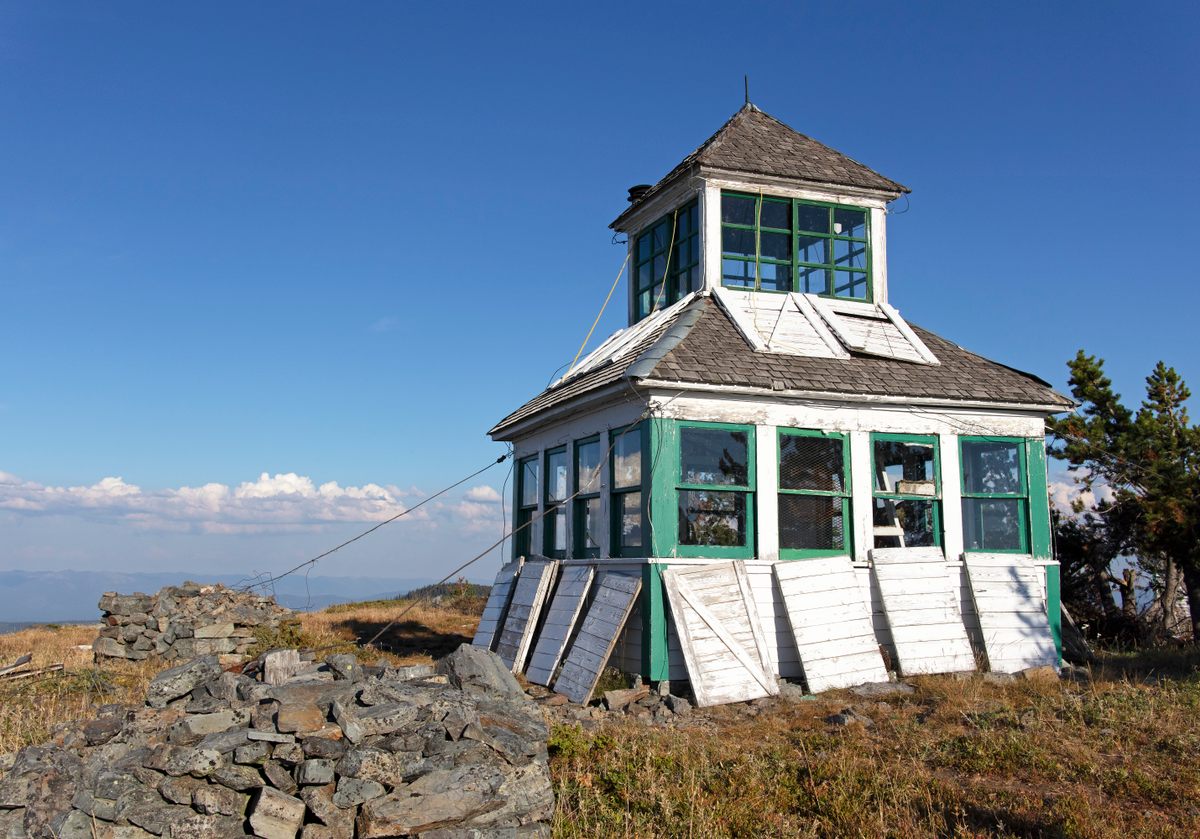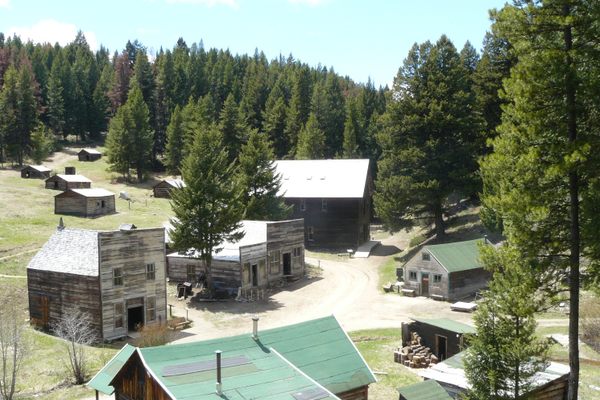
In Montana, Remote Fire Lookouts Keep a Century-Old Tradition Alive
As wildfires rage across the West, an old job feels more critical than ever.
Low-hanging clouds occlude the mountains of nearby Glacier National Park as Leif Haugen drives his pickup truck down a rugged forest road in the predawn darkness. About 20 or so miles north of Polebridge, Montana, Haugen pulls over, lets his dog Ollie out, swings a pack on to his back, and starts hiking down an old logging road. A mile or so down, he spots a small pile of stones and turns into a thick forest for a 3.5-mile hike up to Thoma Lookout.
This is Haugen’s commute.
Thoma is two miles south of the Canadian border and one of a dozen mountaintop fire lookout towers still staffed in the Flathead National Forest and Glacier National Park in the northwest part of the state. A century ago, more than 5,000 of these small buildings were built and staffed across the United States to spot wildfires. Today, only about 300 are still in use, mostly scattered around the West. But just because their numbers have shrunk doesn’t mean they are no longer needed. In places like this, people like Haugen are keeping a critical, century-old tradition alive.

On this cool September day, Haugen is coming off his four-day weekend. From July until late September, he and other lookouts work five- or 10-day stretches searching for new wildfires, which in these parts can burn through tens of thousands of acres in a matter of hours. The week before, Haugen left his post a few days early because he couldn’t see anything in the thick smoke from wildfires in nearby Washington, Oregon, and California that had blanketed the region. While Montana’s fire season has been much calmer this year, the weather’s still been dry; in the previous six weeks, Haugen recorded less than a quarter-inch of rain at the lookout, and this morning his rain gauge is dry again. This means the danger for wildfire remains high. But with the morning dew still hanging on the grass and low clouds everywhere, Haugen knows the day will be slow.
“It’s a simple life really. I read. I walk. I observe the landscape,” he says, heating up some water for tea. “But this job can go from zero to 100 very quickly.”
Haugen, 49, has been a lookout for nearly 30 years. When he was young he read the works of nature writer Edward Abbey and beatnik novelist Jack Kerouac, both of whom worked in lookouts, and was fascinated by what they described as a secluded life on top of a mountain. In college, Haugen had a friend who worked for the U.S. Forest Service, and one day asked him if fire lookouts still existed. He was surprised to learn that they did and the next day he made a call to the local forest supervisor about a summer job.
Fire lookouts (a title that applies to both the person and the place) date back to the 19th century, but really became a popular form of fire detection after the devastating blazes of 1910, which charred 4,700 square miles in Washington, Idaho, and Montana. Between 1910 and World War II, the U.S. Forest Service and other land management agencies built thousands of lookout towers, including more than 600 in Montana. Some were on stilts to provide a view over nearby trees while others, such as Thoma, were constructed right on high ground. Most lookouts are nothing more than one-room cabins with a stove, a bed, and a desk.

In the early days, the people who staffed the lookouts not only spotted the fires but tried to put them out by hiking down to the blaze and using simple tools to starve the fire of fuel by digging a perimeter around it.
Prior to World War II, most of the lookouts were staffed by young men, but when many of them enlisted in the military, the Forest Service had to look elsewhere for help. George Ostrum grew up on a ranch, and when he was 15 years old he lied about his age so that he could work in one of the lookouts in Flathead National Forest (though he notes that it was a small lie, since he turned 16 the first summer, the minimum age for the job).
“I was up there for two months straight and I didn’t see another person,” he says.
After World War II, the Forest Service began to use airplanes to spot fires and many of the lookouts were abandoned, except in the most remote areas. By the 1990s, there were just five staffed lookout towers in Flathead and Glacier, but in recent years managers have restored and staffed some with seasonal employees. Today, there are about a dozen. Thoma had been closed for more than 30 years before it reopened in 2010. Haugen says a staffed lookout provides the forest with an added layer of security: He’s there around the clock for days at a time, while a plane might only pass over once a day. It’s hard to quantify, but every time Haugen spots a fire that is promptly controlled—by dispatched firefighters or fire-retardant-carrying aircraft—he could be saving the Forest Service tens of millions of dollars, not to mention possibly protecting lives and property.
“Fire lookouts are an important part of the Forest Service’s firefighting history but they are still useful in 2020,” says Andy Huntsberger, the fire management officer who oversees the district Thoma is in. “It takes a lot to maintain these buildings but I think it’s worth it.”

Maintenance is one of the things Haugen tackles while he’s up at the lookout. (During the off season, he works as a home builder.) A few days before this chilly morning, Haugen was putting a fresh coat of white paint on the building. Just about everything Haugen needs to live and work comes up on his back, including the paint he was using a few days earlier and the food he’ll eat during this upcoming stretch.
On most days, Haugen gets up with the sun and goes for a walk with his dog. After breakfast, he gathers weather information ahead of the morning radio check-in. At 10 a.m., Haugen calls in to the Kalispell Interagency Dispatch Center to report the temperature, relative humidity, recent precipitation, cloud cover, and visibility. After he clears the channel, the next lookout to the south comes on the air. On some days, in peak fire season, a dozen different lookouts check in. Aside from this, an afternoon check-in, and the occasional hiker, this might be the only human contact Haugen has all day. He’s free to build his day as he pleases. On most days that involves sitting on the porch, reading, and scanning the landscape for smoke.
“Some lookouts will download movies on their computer and watch them up here but I don’t know about that,” he says. “I’m old school. I’m more of a book guy.”
Haugen says he can get through a couple books a week during slow times, but during a busy fire season, those books are likely to sit untouched as he works the radio to help coordinate firefighters.

During lightning storms—the biggest cause of wildfires aside from humans—Haugen sits in the tower with a piece of paper, noting each and every lightning strike and marking its approximate location so that he can reference it later. Sometimes the strikes result in a fire immediately, but other times the fire may smolder in the grass undetected for hours or days. When he sees smoke, he uses a sighting device called an alidade in the middle of the lookout—an Osborne Firefinder, specifically—to pinpoint the fire’s exact location on a circular map of the area. The firefinder was invented by a U.S. Forest Service employee named William B. Osborne in Portland, Oregon, in 1915, and is still used by the agency today.
In 27 years, Haugen has only had to abandon his post once because of an approaching fire. In 2003, the Wedge Canyon Fire came within a few miles of his lookout on Numa Ridge in Glacier National Park—a distance the blaze could easily cover in an afternoon. The Park Service sent in a helicopter with supplies to wrap the lookout building with fire-resistant material, and Haugen helped before evacuating. Thankfully, the fire never reached the site.
While only a dozen of the fire lookouts in northwest Montana are staffed, a number of others survive as mountaintop shelters, and some are even rented out for overnight stays by the Forest Service (though one should be prepared for rustic accommodations, and the need to make reservations months ahead of a visit). Haugen says allowing the public to stay in an actual fire lookout gives them a better idea of what people like him do.

Haugen says he plans on being a fire lookout for as long as he can, and that he’s proud of the service he provides the community. While some people would grow tired of the solitude of being a fire lookout, Haugen says it’s never really bothered him.
“Edward Abbey had a quote about lookouts that went something like, ‘Lookouts either do this job for one year or many,’” Haugen says. “Some people will come up here for a summer, enjoy it, but decide it’s not for them. It’s a different type of person that does this for life.”















Follow us on Twitter to get the latest on the world's hidden wonders.
Like us on Facebook to get the latest on the world's hidden wonders.
Follow us on Twitter Like us on Facebook